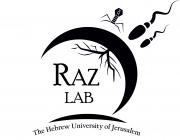Tal Raz Lab
Reproductive Biology & Theriogenology
Koret School of Veterinary Medicine; The Robert H. Smith Faculty of Agriculture, Food & Environment
The Hebrew University of Jerusalem
Koret School of Veterinary Medicine; The Robert H. Smith Faculty of Agriculture, Food & Environment
The Hebrew University of Jerusalem
The Hebrew University websites utilize cookies to enhance user experience and analyze site usage. By continuing to browse these sites, you consent to our use of cookies.

